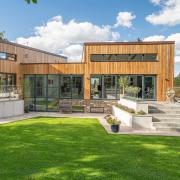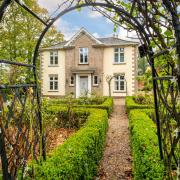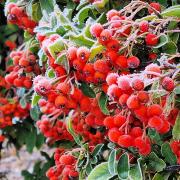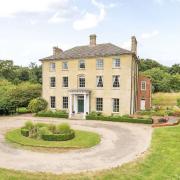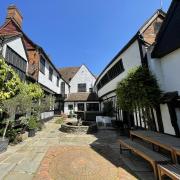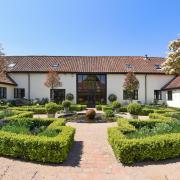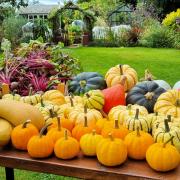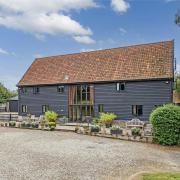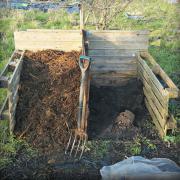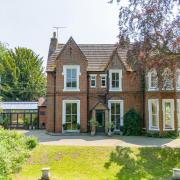Olivia Laing's latest book, The Garden Against Time, feels long overdue.The writer, novelist and art critic been teasing followers on Instagram ever since she moved into her Suffolk home just after the first lockdown, posting glorious images of her restoration of the quintessentially English walled garden she inherited from a former owner, garden designer Mark Rumary.
A passionate gardener herself, Olivia has shared her posies of spring flowers on window sills, magnolia trees in bloom, topiary sculptures by the front door, pots of geraniums in the traditional greenhouse, a lily pond and sundial, and the arched, paint-peeling wooden door in the undulating, 8ft tall, brick perimeter.
The book beautifully and vividly describes how Olivia and her husband came to purchase the house and garden, as well as her life and inspiration in literature, art and horticulture. But it doesn't contain the lush photography her followers might have been expecting.

‘I think garden photography can be slightly unsatisfying,’ says Olivia. ‘It makes you feel more like you aren’t there and aren’t included.’ So she commissioned her neighbour, John Craig, to create exquisite wood engravings of plants and vistas in the garden. They mark the enigmatic chapter breaks throughout, conjuring the magic and dreamlike quality of children’s books, recalling Tom’s Midnight Garden, The Secret Garden and The Children of Green Knowe.
‘This feels the right way to convey what gardens look like,’ Olivia says. She hopes the book takes the reader into the world of their imagination, just as she had to do in its composition.
‘We were in lockdown so I couldn’t visit gardens or archives,’ she says. ‘I had to go on journeys of my mind, and find these trails through history, through time. It was almost like dreaming of a person, slightly out of reach.’

Like many of us during the pandemic, she turned to books for her way out of the isolation and stasis of that time. She rediscovered the life and poetry of John Clare, the creativity of William Morris and the philosophy of John Milton.
She explored language, too, by delving into the Oxford English Dictionary to find that our definitions of words such as ‘paradise’ and ‘landscape’ are far removed from the original, earlier usage. She used the contemporary, global and political upheaval we were experiencing to look at how gardens had been created in the past through exploitation and privilege, and what we could do to create a better future for our natural and societal world.
‘I think gardens encode a kind of richness,’ says Olivia, ‘a kind of holiness and a sort of creative exchange; you put work into something that comes back. In some ways it's uncertain, but in some ways it's very certain. I think that sense of gardening being reparative in some ways is why it's so popular. It's not just a Sunday hobby. It goes deeper.’

For Olivia, gardens are associated with powerful memories. Her parents split up when she was four and every weekend her father would take her and her sister to visit country estates and grand gardens for their time together.
‘I think gardens were a way to feel rooted for me,’ says Olivia. ‘It was the home in a way, more than the house.’ Not owning a house until her 40s, she had always tried to create a garden wherever she was, even when living in a tree and on an abandoned farm as an environmental activist in her twenties.

Having married the poet Ian Patterson seven years ago, Olivia’s place of her own came to be this house and garden in Suffolk when they moved here in 2020. Her excitement, still, is evident and infectious. The couple left Cambridge to be nearer family and an aunt had spotted the house in a local newspaper. Roses round the door and a connection with an acclaimed garden designer piqued Olivia and Ian’s interest.
‘We wanted somewhere we could make a garden together,’ she says. ‘And there’s something about Suffolk that’s mysterious. The dissolving coast, the way that you go to the beach and it’s different every time. The feeling of being in flux. And nature being quite powerful here - that drew me.’

Initially hoping to combine her love of both the city and country life by travelling back and forth to London, Olivia was instead confined to bed for two months during the lockdown with pleurisy. This was when she became obsessed, she says, with finding out about Mark Rumary. ‘I had never heard of him, but I did know of Notcutts where he was the chief designer.’
She sought out his book, The Dry Garden, to read. Two essays had also been left behind by the previous owners of the house. Then she started calling anyone she thought might have a connection with Rumary.
‘Everyone wanted to talk about him,’ she says. ‘I had a lovely feeling of being part of a detective story, finding out about this person who was a bit underrated in the world at large but very known in the horticultural world. And then uncovering what he had planted in the garden.

‘There was a secret garden feel of something somebody had made here. Some of it has remained, some of it is lost. I wondered what I'd see. I wondered how much I would like. It was the most amazing experience to have at a time when you're trapped in one place. It became a voyage of discovery.’
The Garden Against Time similarly provides an abundance of riches and surprises with each turn of the page, combining memoir, literature, art, history and political debate – rather like Olivia’s garden, a sequence of rooms with each space feeling different and discrete, connected by paths. And it’s all conveyed through a tranquil, soothing voice.
‘I wanted to write something that was an invitation into a beautiful, calm, gentle space,’ says Olivia. ‘Where the reader from any political background could examine ideas without feeling they were being shouted at. That they might reflect on things without feeling they were being forced to take a position. I’m sick of polarisation, of feeling that people aren’t listening to each other.’

This is Olivia’s sixth book of non-fiction. All her works have combined memoir with cultural criticism, psychology, history and place while variously exploring creativity and alcoholism, loneliness, art, and freedom.
‘I’m very much a left-wing person and am very involved in queer communities, but I do have a desire to communicate to people who don't think like me, and to find a way to have a conversation that isn't polarised, but maybe allows them to think in new ways,’ she says.
And just as this book will appeal to gardening experts, it will also delight those who aspire to garden. ‘It was really important to get the balance,’ Olivia says. ‘A friend said, “I know nothing about gardens, but it was like the Shipping Forecast”. Some people will know exactly what plants I’m talking about but others will just go “what beautiful words”.’
The Garden Against Time: In Search of a Common Paradise is published by Picador





